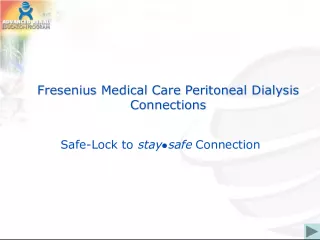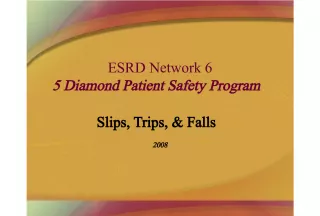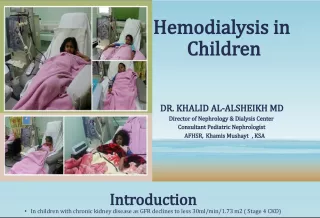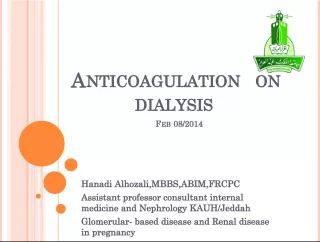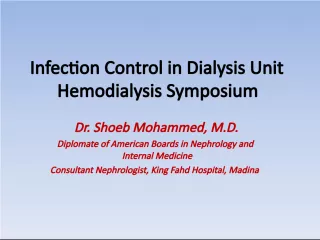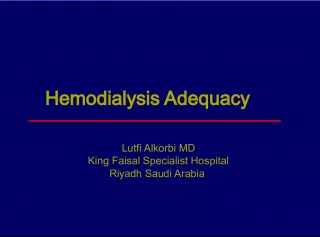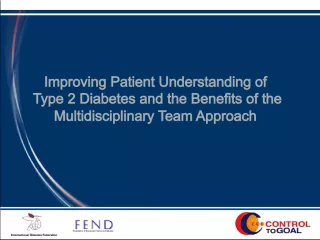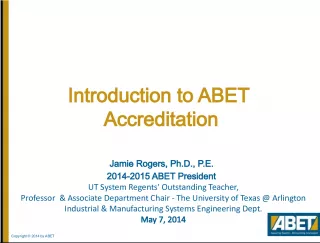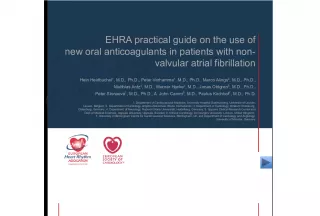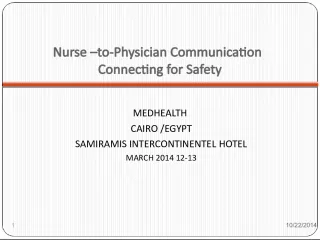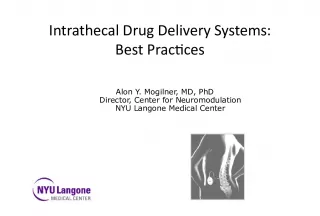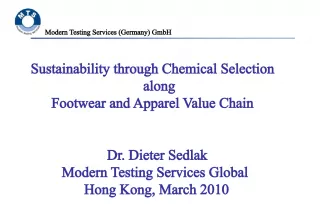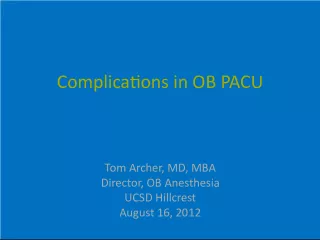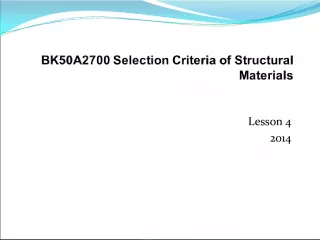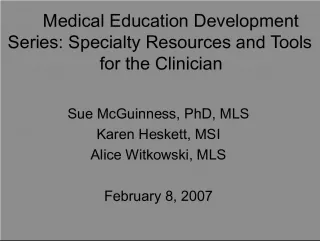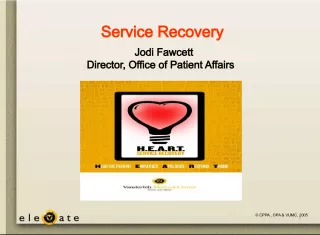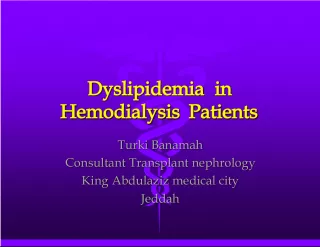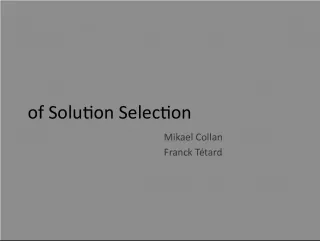Peritoneal Dialysis: Understanding the Modality and Patient Selection Criteria


This presentation by Fresenius Medical Care North America provides a basic introduction to Peritoneal Dialysis (PD) and highlights the importance of patient selection criteria as a key component of a successful PD program. It covers the understanding of the modality and the components of a successful PD program.
- Uploaded on | 19 Views
-
 tracyjordan
tracyjordan
About Peritoneal Dialysis: Understanding the Modality and Patient Selection Criteria
PowerPoint presentation about 'Peritoneal Dialysis: Understanding the Modality and Patient Selection Criteria'. This presentation describes the topic on This presentation by Fresenius Medical Care North America provides a basic introduction to Peritoneal Dialysis (PD) and highlights the importance of patient selection criteria as a key component of a successful PD program. It covers the understanding of the modality and the components of a successful PD program.. The key topics included in this slideshow are . Download this presentation absolutely free.
Presentation Transcript
1. 2006 Fresenius Medical Care North America Turning the Light on Peritoneal Dialysis: A Basic Introduction to PD Turning the Light on Peritoneal Dialysis: A Basic Introduction to PD
2. 2006 Fresenius Medical Care North America Turning the l ight on Peritoneal Dialysis (PD) Turning the l ight on Peritoneal Dialysis (PD) I. Understanding the modality II. Patient selection criteria III. Components of a successful PD program
3. 2006 Fresenius Medical Care North America Goal statement Goal statement The goals of this presentation are to understand peritoneal dialysis and to recognize patient selection criteria as one component of a successful PD program.
4. 2006 Fresenius Medical Care North America Learning o bjectives Learning o bjectives At the end of this presentation the participant will be able to: Describe the components of a successful PD program. List the organization that provides guidelines for peritoneal dialysis including appropriate patient selection. Describe the difference between peritoneal dialysis and hemodialysis Describe the function of the peritoneal membrane and dialysate in peritoneal dialysis.
5. 2006 Fresenius Medical Care North America Understanding the Modality: Principles of Peritoneal Dialysis Understanding the Modality: Principles of Peritoneal Dialysis
6. 2006 Fresenius Medical Care North America Before we can discuss how to grow a PD program we need to understand the modality. The next few slides will be a brief review of principles of PD. Lets look at how PD can be used as a renal replacement therapy.
7. 2006 Fresenius Medical Care North America The structure of the peritoneum The structure of the peritoneum Living, serous membrane Can be damaged Semi permeable and selective Filters various kinds of solute to varying degrees Forms a closed sac in males and in females the sac is open at the fimbria of the fallopian tubes Is comprised of two principal types Visceral peritoneum around the internal organs Parietal peritoneum lining the abdominal wall
8. 2006 Fresenius Medical Care North America Size approximates body surface area Approximates the surface area of the skin 1- 2m 2 in most adults Proportionately larger in infants and small children Effective surface area is about 1m 2 Size equivalent to a hemodialyzer Size is fixed Can lose effective surface area The structure of the peritoneum The structure of the peritoneum
9. 2006 Fresenius Medical Care North America Peritoneal d ialysis is an internal technique for blood purification Peritoneal d ialysis is an internal technique for blood purification PD is dialysis but is unlike extracorporeal (out of the body) dialysis systems Nature provides Blood path Membrane Dialysate compartment
10. 2006 Fresenius Medical Care North America The peritoneal membrane forms the peritoneal cavity which functions as the dialysate compartment The membrane is semi-permeable and selectively filters solutes to varying degrees Capillaries within the membrane provide the blood pathway Peritoneal dialysis is an internal technique for blood purification Peritoneal dialysis is an internal technique for blood purification
11. 2006 Fresenius Medical Care North America Anatomy of the p eritoneum Anatomy of the p eritoneum
12. 2006 Fresenius Medical Care North America The peritoneum Forms folds between organs and elsewhere. The folds which are reflected from the walls over the viscera are called mesenteries. The folds can connect viscera to each other or anchor organs to the abdominal wall. The greater omentum is a fold in the serosa of the stomach that hangs down like an apron over the front of the intestines. Tends to be larger in heavy or previously heavy individuals. PD catheter can become entangled in the omentum. Anatomy of the peritoneum Anatomy of the peritoneum
13. 2006 Fresenius Medical Care North America Peritoneal cavity Peritoneal cavity Potential rather than an actual space Normally contains approximately 100 ml Dialysate volumes which are usually 2 - 4 L can result in: Discomfort Respiratory embarrassment (especially if there is a thoracic leak) Decreased food intake secondary to a sensation of fullness Problems related to fluid weight or pressure such as back pain, hernia or fluid leak into tissues
14. 2006 Fresenius Medical Care North America Anatomy of the p eritoneum Anatomy of the p eritoneum Peritoneal Cavity
15. 2006 Fresenius Medical Care North America A catheter (which is a foreign body) placed in the cavity can cause: Discomfort related to catheter or fluid pressure (rectal, bladder, penile) Poor drainage because the catheter floats freely in the peritoneal cavity and may become: Displaced or flipped up from pelvic gutter Wrapped in the omentum Entangled bowel loops Soft tissue penetration by the catheter (rare) Peritoneal cavity Peritoneal cavity
16. 2006 Fresenius Medical Care North America Function of the peritoneum - solute transport and clearance Function of the peritoneum - solute transport and clearance Lets examine how solutes are transported across the peritoneal membrane. The peritoneal membrane is the patient's tool for doing the work of dialysis. Membrane capability varies from person to person but is usually stable in an individual.
17. 2006 Fresenius Medical Care North America Diffusion Diffusion Solute movement from an area of higher concentration to an area of lower concentration Movement continues until equilibrium occurs
18. 2006 Fresenius Medical Care North America Diffusion and dialysis Diffusion and dialysis Diffusion occurs across a membrane that is semi-permeable. There are different degrees of permeability to solutes of different sizes. Net transfer of molecules occurs until an equal concentration of a given solute on both sides of the membrane. Movement continues but there is no net change in concentration from one side to another.
19. 2006 Fresenius Medical Care North America Diffusion and dialysis Diffusion and dialysis In this diagram the green triangles and red circles represent two different molecules that transport at different rates. We see that the red circles are already in equilibrium on both sides of the membrane while the green triangles are not yet equilibrated. If this were to represent dialysis, then there would be no further removal of the red circles but green triangles could still be further dialyzed off.
20. 2006 Fresenius Medical Care North America Osmosis Osmosis Water movement from an area of lower to higher solute concentration Ultrafiltration, or the amount of water removed, is related to the osmotic pressure gradient Blood Dialysate
21. 2006 Fresenius Medical Care North America Osmosis and dialysis Osmosis and dialysis In this diagram the Ds represent dextrose, the solute used as an osmotic agent. The dialysis solution is very highly concentrated compared to blood so that water moves into the dialysate. O s m o s i s Blood Dialysate
22. 2006 Fresenius Medical Care North America Test yourself Test yourself 1. The peritoneum removes solutes and fluids much like the dialyzer or artificial kidney in hemodialysis. True False 2. The peritoneal membrane forms the peritoneal cavity which functions as the dialysate compartment. True False 3. Osmosis moves solutes out of the blood and into the dialysate. True False
23. 2006 Fresenius Medical Care North America Answers for test yourself Answers for test yourself 1. The peritoneum removes solutes and fluids much like the dialyzer or artificial kidney in hemodialysis. Answer: True. The peritoneum is a semi-permeable membrane and filters solutes and water during peritoneal dialysis. 2. The peritoneal membrane forms the peritoneal cavity which functions as the dialysate compartment. Answer: True 3. Osmosis moves solutes out of the blood and into the dialysate. Answer: False. Osmosis is the movement of water from an area of lower concentration to an area of higher concentration.
24. 2006 Fresenius Medical Care North America PD Therapies: Understanding the different types of PD PD Therapies: Understanding the different types of PD
25. 2006 Fresenius Medical Care North America Continuous therapies Continuous therapies Continuous Ambulatory Peritoneal Dialysis (CAPD) 4 - 5 exchanges* /24 hours 2L - 2.5L exchanges* 8 - 10L per 24 hours* The exchanges are done manually by the patient *May be more Dialysate is present in the peritoneal cavity at all times
26. 2006 Fresenius Medical Care North America Continuous therapies Continuous therapies Continuous Cycling Peritoneal Dialysis (CCPD) Machine automated during sleep hours 10 - 12 hours at night 8L or more at night 2L or more during the day 10L or more in 24 hours Dialysate is present in the peritoneal cavity at all times
27. 2006 Fresenius Medical Care North America Continuous therapies Continuous therapies PD Plus: Utilizing the cycler for a daytime exchange in addition to cycling at night Night cycles for 8 10 hours All exchanges delivered by cycler Pause exchange Night exchanges Daytime fill 10L or more / 24 hours Dialysate is present in the peritoneal cavity at all times
28. 2006 Fresenius Medical Care North America PD solutions: Understanding what is in the dialysate PD solutions: Understanding what is in the dialysate Composition of PD solutions: Sodium 132 mEq/L Potassium none Calcium 2.5 - 3.5 mEq/L Chloride 96 - 102 mEq/L Sodium lactate 448 gm/100ml Magnesium 0.5 - 1.5 mEq/L Dextrose 1.5% - 4.25%
29. 2006 Fresenius Medical Care North America Dialysis exchange process Dialysis exchange process Fill Drain Dwell An exchange should take approximately 20-40 minutes to complete.
30. 2006 Fresenius Medical Care North America The drain phase The drain phase Drain About 15 - 25 minutes and depends on: Catheter function Amount of solution Gravity Diameter of tubing Position or intra-abdominal pressure Condition of system
31. 2006 Fresenius Medical Care North America The fill phase The fill phase Fill About 10 minutes and depends on Amount of solution Solution bag height Diameter of tubing Intra-abdominal pressure Condition of system
32. 2006 Fresenius Medical Care North America The dwell The dwell Dwell (a prescribed time) Dialysis takes place during the dwell time Time required for transport of solutes across the peritoneum CAPD Usually 4 - 5 hours during the day and 9 hours at night Cycling Usually 1 - 3 hours at night and 15 hours during the day
33. 2006 Fresenius Medical Care North America Test yourself Test yourself Peritoneal dialysis can be done manually or by a machine as the patient prefers. True False The fill time is the time that it takes to a. Stay in the peritoneal cavity b. Allow the dialysate to flow out of the cavity into a bag c. Drain fresh dialysate from the bag into the peritoneal cavity
34. 2006 Fresenius Medical Care North America Answers for test yourself Answers for test yourself Peritoneal dialysis can be done manually or by a machine as the patient prefers. Answer: True The fill time is the time that it takes to c. Drain fresh dialysate from the bag into the peritoneal cavity, filling the cavity with the dialysate fluid
35. 2006 Fresenius Medical Care North America Test yourself Test yourself An exchange consists of _____ and ______. a. drain and fill b. fill and dwell c. fill, dwell and drain Continuous means that dialysate a. is always present in the peritoneal cavity b. is present except during the day c. is present except at night PD cyclers are most commonly used while the patient sleeps True False
36. 2006 Fresenius Medical Care North America Answers to test yourself Answers to test yourself An exchange consist of _____ and ______. a. drain and fill Continuous means that dialysate a. is always present in the peritoneal cavity PD cyclers are most commonly used while the patient sleeps True
37. 2006 Fresenius Medical Care North America Patient selection criteria: Who should do peritoneal dialysis? Patient selection criteria: Who should do peritoneal dialysis?
38. 2006 Fresenius Medical Care North America Patient selection criteria Patient selection criteria There are some patients for whom PD may be a better option than hemodialysis. There are pros and cons regarding modality selection for any patient. Selection of patients who may do better on PD or for whom PD may be contraindicated as per the KDOQI guidelines will be reviewed.
39. 2006 Fresenius Medical Care North America K/DOQI Guideline 29 1 : Indications for PD K/DOQI Guideline 29 1 : Indications for PD Patients who prefer PD or will not do hemodialysis. Patients report improved quality of life 2 and that they are more satisfied with their treatments when compared to hemodialysis (HD) patients Pediatric patients No vascular access needed Due to the difficulties in maintaining vascular access in infants and small children, PD is usually the modality of choice when weight is < 20 kg. More gentle treatment Regular school attendance Can be best achieved by a home modality . 1.National Kidney Foundation. NKF K/DOQI Guidelines http://www.kidney.org/professionals/kdoqi/guidelines 2.Merkus, MP. American Journal of Kidney Disease 29: 584-592, 1997
40. 2006 Fresenius Medical Care North America Patients who cannot tolerate HD Congestive/ischemic heart disease 1 Due to the rapid shifting of volume within fluid compartments during HD, some patients with severe cardiac disease may be better managed on PD. Patients on PD have a lower incidence of left ventricular hypertrophy, arrhythmias, and hypertension compared to that of HD patients. 1. Canziani, ME. Artificial Organs 19(3):241-244, 1995 K/DOQI Guideline 29: Indications for PD K/DOQI Guideline 29: Indications for PD
41. 2006 Fresenius Medical Care North America Extensive vascular disease and Vascular access problematic patients Extensive peripheral or central venous occlusive disease prohibits surgical placement of some types of hemodialysis access. These patients are at risk of severe ischemia or even gangrene following placement of vascular access. Marginal vascular beds are at risk for ischemia or reduced perfusion during hypotension, which is frequent in some HD patients. These patients benefit from the increased vascular stability achieved with PD. Canziani, ME. Artificial Organs 19(3):241-244, 1995 K/DOQI Guideline 29: Indications for PD K/DOQI Guideline 29: Indications for PD
42. 2006 Fresenius Medical Care North America Additional considerations for patients that would do well on PD Additional considerations for patients that would do well on PD Distance from dialysis facility Patients living in rural communities or where severe weather could be problematic. Nursing home patients Eliminates the difficulties with transportation three times per week. Working patients Avoids treatment scheduling conflicts Patients who work report increased satisfaction with dialysis Diabetic patients No vascular access needed IP (intra-peritoneal) insulin option
43. 2006 Fresenius Medical Care North America K/DOQI Guideline 30: Absolute Contraindications for PD K/DOQI Guideline 30: Absolute Contraindications for PD Documented loss of peritoneal function or extensive abdominal adhesions that limit dialysate flow. PD efficiency relies on effective peritoneal blood flow, dialysate flow, sufficient peritoneal surface area and peritoneal transport rate to allow adequate solute and fluid removal. Any compromise in these functions may result in inadequate peritoneal dialysis and thus the failure of PD. There is no way of knowing the functionality of the peritoneum until it is tried. Many patients who have been on PD and were transplanted have successfully returned to PD post transplant failure. National Kidney Foundation. NKF K/DOQI Guidelines http://www.kidney.org/professionals/kdoqi/guidelines
44. 2006 Fresenius Medical Care North America Absence of suitable assistant in the patient who is physically or mentally incapable of performing PD. Performing PD requires certain physical and intellectual capabilities in the patient and/or caregiver. It is important that the patient and/or the caregiver be able to identify and troubleshoot any problems that may arise during PD. Be open minded, blind patients, patients who cannot read, and patients with severe physical limitations have been successful PD patients. National Kidney Foundation. NKF K/DOQI Guidelines http://www.kidney.org/professionals/kdoqi/guidelines K/DOQI Guideline 30: Absolute Contraindications for PD K/DOQI Guideline 30: Absolute Contraindications for PD
45. 2006 Fresenius Medical Care North America Uncorrectable mechanical defects that prevent effective PD or increase the risk of infection (e.g., surgically irreparable hernia, omphalocele, gastroschisis, diaphragmatic hernia and bladder extrophy.) The dialysate must come into contact with the vascular bed of the peritoneum, otherwise dialysis will not be accomplished. These congenital birth defects involve a weakening of in the abdominal wall wherein abdominal organs herniate. National Kidney Foundation. NKF K/DOQI Guidelines http://www.kidney.org/professionals/kdoqi/guidelines K/DOQI Guideline 30: Absolute Contraindications for PD K/DOQI Guideline 30: Absolute Contraindications for PD
46. 2006 Fresenius Medical Care North America K/DOQI Guideline 31: Relative Contraindications for PD K/DOQI Guideline 31: Relative Contraindications for PD Peritoneal leaks Body size limitations Intolerance to PD volumes necessary to achieve adequate PD dose Inflammatory or ischemic bowel disease Abdominal wall or skin infection Morbid obesity (in short people) Severe malnutrition Frequent episodes of diverticulitis National Kidney Foundation. NKF K/DOQI Guidelines http://www.kidney.org/professionals/kdoqi/guidelines
47. 2006 Fresenius Medical Care North America Patients with relative contraindications account for a only small portion of PD candidates and this population is not significant enough to impact the low PD utilization rate that we see in the US today. This section of the K/DOQI guidelines is opinion based. National Kidney Foundation. NKF K/DOQI Guidelines http://www.kidney.org/professionals/kdoqi/guidelines K/DOQI Guideline 31: Relative Contraindications for PD K/DOQI Guideline 31: Relative Contraindications for PD
48. 2006 Fresenius Medical Care North America Test yourself Test yourself There are written guidelines regarding patient selection criteria True False For some patients PD is a better option because it places less stress on the cardiovascular system. True False Documented extensive abdominal adhesions that limit dialysate flow will not impede PD True False
49. 2006 Fresenius Medical Care North America Answers to test yourself Answers to test yourself There are written guidelines regarding patient selection criteria True For some patients PD is a better option because it places less stress on the cardiovascular system. True Documented extensive abdominal adhesions that limit dialysate flow will not impede PD False, this is a contraindication for peritoneal dialysis.
50. 2006 Fresenius Medical Care North America Building the components of a successful PD program Building the components of a successful PD program Physician support Active and effective modality education program Program infrastructure
51. 2006 Fresenius Medical Care North America Physician support - why it may be low Physician support - why it may be low Minimal training of PD during fellowships leads to physician: Lack of confidence Concern with managing side effects Perception that adjustments of Rx are more involved with PD than HD Perception that PD is more labor/time intensive Campbell, D. Nephrology News and Issues 25-27 , 2004
52. 2006 Fresenius Medical Care North America Steps to improve physician support Steps to improve physician support Encourage the physician to attend an education program designed to increase comfort with PD Provide articles that promote the modality and the importance of modality options education
53. 2006 Fresenius Medical Care North America Components of a successful modality education program Components of a successful modality education program Modality education process developed and agreed upon by multidisciplinary team Dedicated nurse with hours specified to monthly patient modality education meetings Physician commitment to refer patients Education of hemodialysis staff PD awareness days for hemodialysis patients Tracking program to monitor success and identify opportunities for improvement
54. 2006 Fresenius Medical Care North America Modality education Modality education Benefits of early referral Improves management of comorbid conditions Allows for timely education in treatment options and referral for permanent access placement Identifies target patient population: 1 Creatinine > 3mg/dl Anticipated treatment start within 1 year New hemo starts who did not receive information 1. National Kidney Foundation. NKF K/DOQI Guidelines http://www.kidney.org/professionals/kdoqi/guidelines
55. 2006 Fresenius Medical Care North America There are defined parameters for the program developed by the multi disciplinary team, especially the referring nephrologist The nephrologist must clearly communicate patient referrals to the staff The referral process will ensure a positive flow of patients to your modality education monthly class In addition to new CKD patients, a successful program will include education of hemodialysis patients Modality education Modality education
56. 2006 Fresenius Medical Care North America Educators partner with clinic managers to obtain admission reports Education promotes a proactive approach to access placement thus decreasing the percentage of vascular catheters being utilized The points at which patients may enter the program vary and but can be anywhere from one year to six months prior to initiation of dialysis Modality education Modality education
57. 2006 Fresenius Medical Care North America Monthly modality education classes should: Monthly modality education classes should: Provide regular monthly treatment education programs discussing Treatment options Diet and nutrition Living with dialysis Support systems Financial needs/concerns
58. 2006 Fresenius Medical Care North America Education of hemodialysis staff Education of hemodialysis staff Increases understanding of peritoneal dialysis Assists PD nurse to identify potential candidates who did not have the opportunity to participate in their own modality selection ( such as acute starts) Dissolves myths regarding PD You will get an infection You are on the machine for 15 hours at night Large patients cannot meet adequacy targets
59. 2006 Fresenius Medical Care North America PD awareness days for hemodialysis patients PD awareness days for hemodialysis patients Objective: Heighten awareness of HD patients to the clinical and lifestyle benefits of PD therapy. Acute starts Patients who were uremic when they started and now want to know more about PD. Patients who have returned to work and desire a more flexible lifestyle
60. 2006 Fresenius Medical Care North America How to conduct a PD awareness day How to conduct a PD awareness day Requires support of physician and entire staff Provide a lunch-n-learn for hemo staff prior to PD awareness days to ensure its success Place posters marking the PD awareness dates throughout the facility Meet with each hemodialysis patient during treatment Follow up with physician, PD nurse and/or educator regarding patients who are interested in possibly switching
61. 2006 Fresenius Medical Care North America Methods to develop a positive PD program infrastructure Methods to develop a positive PD program infrastructure Dedicate a PD nurse with regularly scheduled hours for PD Ensure on-call PD support Develop new PD programs where appropriate, to reduce travel time for patients and physicians Develop float positions to cover smaller and new programs and backup for large programs Utilize vendor on site education and continuous education sessions Establish protocols for ease of treatment Educate local hospitals and extended care facilities for continuity of treatment
62. 2006 Fresenius Medical Care North America In summary In summary To have a successful PD program Understand the modality Understand the right type of patient for PD Know your physicians beliefs and offer positive educational offerings to increase his/her support Develop and implement an active and effective modality options program Promote a positive infrastructure within your home training program
